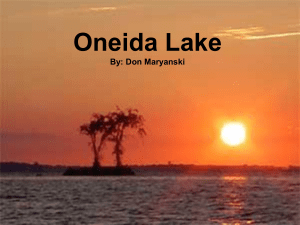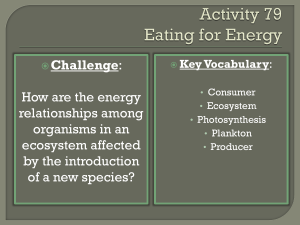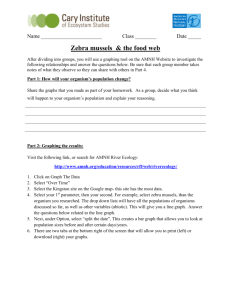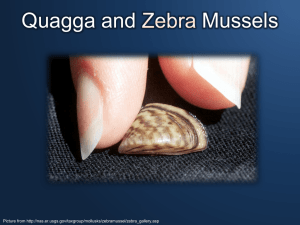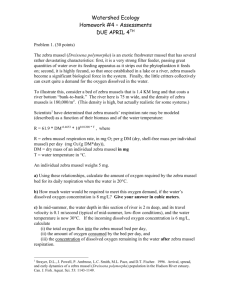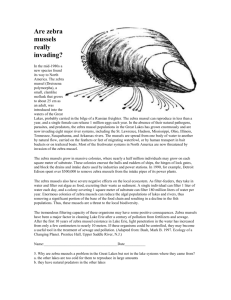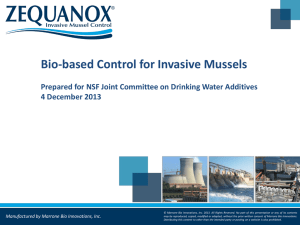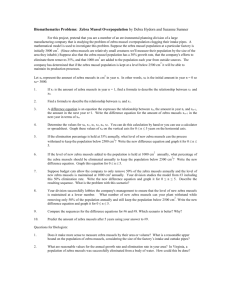Water Clarity & Secchi Disk: Lake Ontario Ecosystem
advertisement
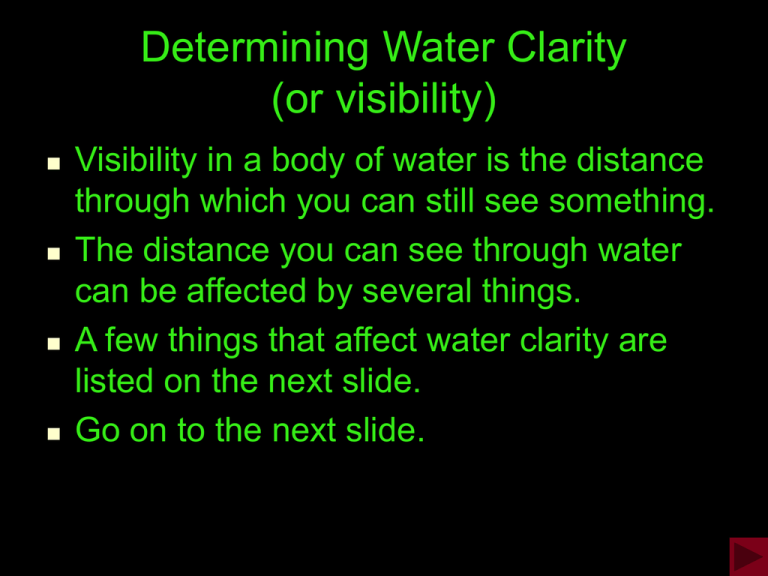
Determining Water Clarity (or visibility) Visibility in a body of water is the distance through which you can still see something. The distance you can see through water can be affected by several things. A few things that affect water clarity are listed on the next slide. Go on to the next slide. Things that affect clarity Amount of algae in the water Dirt from erosion Churned up sediment from the bottom of the body of water Amount of small organisms living in the water Take a moment to write these things down on your activity report. Testing Visibility Visibility through a body of water can be tested with a device called a “Secchi (seh-key) disc.” A Secchi disc is pictured here. The disc is attached to a rope and lowered into water until it is no longer visible. Go on to the next slide Using a Secchi Disc There is a Secchi disc apparatus set up by the entrance to the laboratory. You will use the device to determine the depth of visibility in the water sample provided. Go on to the next slide Why measure visibility in water? The visibility through a sample of water can provide us with valuable information about the ecosystem of the body of water. Lake Ontario is currently suffering from an overpopulation of zebra mussels that eat the microorganisms in the water. Go on to the next slide Secchi disk activity You will be doing this activity with the Secchi disk by the door to the lab. Take out the binder in your drawer and turn to the Secchi disk activity section. Once you complete the Secchi disk activity, you may go on to the next slide. An Underwater Ecosystem Algae, or “phytoplankton,” has a significant affect on the amount of visibility in water. The next slide has a diagram of a food chain in Lake Ontario. Write down the creatures that zebra mussels eat, and what eats zebra mussels. Go on to the next slide Trout, Salmon Warm water Sport fish Large, exotic Zooplankton Alewife Juvenile Fish Zooplankton (Tiny animals) Gobies Sturgeon Zebra Mussels Quagga Mussels Phytoplankton (Microscopic Plants) Sunlight Nutrients Use this chart to find out some information about all of the different lake organisms. You can write down your observations on your worksheet. A disturbed balance The picture to the right is a zebra mussel. The zebra mussel is a species that is not native to the great lakes. The best explanation is that the zebra mussels came into the lakes on ships. Go on to the next slide. Zebra Mussels Zebra mussels do not have many natural predators in the Great Lakes. The lake sturgeon, which is pictured to the right, is one of the only predators of zebra mussels in Lake Ontario. Finish writing your observations on the worksheet. Once you are done, go on to the next activity! Trout are freshwater fish that are related to salmon. They are a part of a subdivision of the salmon family called “Salmoninae.” The Lake Trout used to be the primary predator of Lake Ontario, but almost reached extinction in the lake due to over-fishing and environment destruction. Return to Food Chain The Alewife is a small fish that is second in command in the Lake Ontario food chain. It feeds on zooplankton (Tiny aquatic animals) Return to Food Chain The pictures on this slide are some of the large zooplankton that can be found in Lake Ontario. Zooplankton are sometimes called “brine shrimp.” They can be visible with the naked eye or microscopic. Return to Food Chain Gobies are an aggressive species of bottom dwelling fish that are not native to Lake Ontario. They were brought here in the ballast of cargo ships. Lake Sturgeon can grow to be very large in size. (six to eight feet) They are an endangered species because they used to be hunted heavily for their caviar. (eggs) Return to Food Chain Zooplankton are microscopic creatures that are one of the building blocks of the Lake Ontario food chain. The population of zooplankton can fluctuate extremely rapidly based on the chemistry of the water. If there is pollution in the water, the zooplankton are some of the first to feel it. Return to Food Chain The creature on the left is a zebra mussel. The Zebra Mussel originated in the Caspian Sea, which is Bordered by Russia. It was brought to the United States by cargo ships. The image on the right is a Quagga Mussel. The Quagga mussel prefers cold and deep waters. It too was brought to the United States from Russia in the ballast tanks of oceanliners. Return to Food Chain Phytoplankton are microscopic plants. They are responsible for the basis of food production in Lake Ontario. Return to Food Chain Go On To Next Slide Sunlight is needed for plants to do photosynthesis to make food. Return to Food Chain
